There are a lot of unique cities around the world but Tokyo is one of those that can mix both ancient and modern trends. Mainly known for busy streets and high-rise buildings, this city has old temples, state-of-the-art technology as well as an experience of various cultures.
For instance, in the likes of Shibuya and Shinjuku, one can find exciting spots to visit such as serene Meiji Jingu shrine where seafood lovers would go to taste Japanese cuisine known globally. Akihabara is a place full liveliness while Ueno Park offers an environment characterized by peace. Thus, due to these different types of activities that it contains which are suitable for everyone’s taste buds who love traveling, Tokyo is still considered to be one of the most amazing places on earth.
Map
Tokyo Tower

It is the emblem of Japan’s swift recovery and modernization after World War II. Tokyo Tower, built in 1958 and modeled on Paris’s Eiffel Tower, serves as a broadcasting antenna for television and also a tourist attraction. The tower has bright orange and white color scheme that provides visibility to pilots flying above Tokyo, thus it cannot be confused with anything else. For example, it was the tallest building in Japan until 2012 when Tokyo Skytree was completed; however, its old-fashioned glamour and panoramic city landscape still captivate tourists’ hearts.
Significance
Designing and Building: It is influenced by the Eiffel Tower though it is taller by 13 meters yet half as heavy which reflects improvements in steel fabrication processes that were available during 1950s. It represents Japanese ambitions after their successful recovery from the war.
Cultural Icon: Numerous films, television series and artworks have featured Tokyo tower making it a cultural icon not only in Japan but also worldwide.
Nearby Attractions
- Zojoji Temple: This ancient temple lies at the bottom of the tower providing an opposite case with Tokyo’s modernity. The contrasting presence of the historic building beside an ultra-modern one makes a perfect illustration of how this city combines newness with tradition.
- Roppongi Hills: A few meters past Tokyo Tower there is modern complex comprising art museum, shopping malls, restaurants as well as observation deck offering alternative perspectives about Tokyo Town.
- Shiba Park: Among other parks around, Shiba Park near this structure is ideal for gentle walking or picnicking that enables visitors see appealing greenery surrounding old architecture amidst makihara.
Senso-ji Temple

Senso-ji Temple in the lively Asakusa district of Tokyo is the oldest temple in the capital and one of its most important cultural landmarks. This Buddhist temple, founded in 628 AD, is dedicated to the bodhisattva of compassion Kannon Bosatsu and draws millions of visitors every year. Senso-ji has a striking red gate and a giant lantern and it is a center for activity, spirituality, and tradition; an immersion into Japan’s deep religious history.
Significance Architectural and Historical
Historic structures: The major gateway to the shrine called Kaminarimon (Thunder Gate) features an immense red lantern which serves as an icon for Japan’s universal heritage. Behind it lies Nakamise Street which is a vibrant lane for shopping leading to Hozomon, second gate to the temple complex.
Main Hall and Pagoda: The main hall (hondo) and the five-storied pagoda are examples of refined Japanese architectural style that have been beautifully restored after suffering damage from World War II which retained their original look while incorporating modern techniques.
Culture And Artistic Highlights
Nakamise street: Stalls at Nakamise sell typical snacks, crafts, souvenirs where tourists can experience old Tokyo especially if they want special unique presents or food items from Japan.
Seasonal festivals & events: Among these are Sanja Matsuri (Sanja Festival) which is one of largest lively celebration throughout Tokyo marking Senso-ji’s three founding gods.
Nearby Attractions
- Asakusa Shrine: It is found next door to Senso-ji offering another culturally rich excursion but with less people around.
- Sumida River: It just takes several minute walk to reach this river bank which opens up breathtaking views as you take part in boat tours that unveil another side of the cityscape life.
- Asakusa Culture Tourist Information Center: It offers a refreshing look over this place due to its observation deck in addition to giving tips on other local spots and occasions.
Meiji Shrine
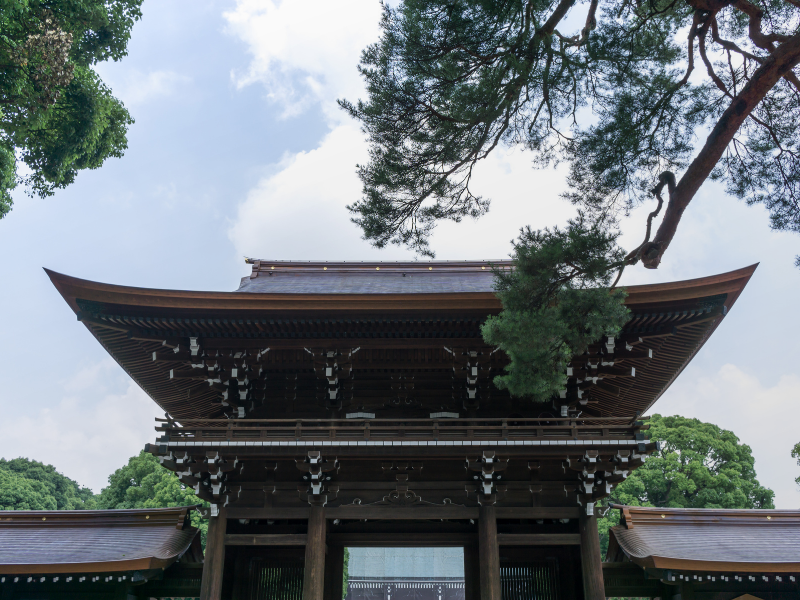
There is a big forested area in the middle of Tokyo where Meiji Shrine (Meiji Jingu) is nestled. This shrine was dedicated to Emperor Meiji, who was deified. It also commemorates his wife Empress Shoken. The shrine’s construction took place in 1920 as Japan underwent a critical transition from feudalism into modernity. Today, Meiji Shrine stands as an important cultural and religious site attracting many locals and tourists who always find peace in this busy city.
Significance of Architecture and History
Traditional Shinto Architecture: This is a typical example of Nagarezukuri architectural style found in Meiji Shrine which is known for its simplicity and materials that are mostly natural, such as wood. The gateways of the shrine are huge torii gates that have been made using old Japanese cypress trees (sugi), indicating the beginning of Yoyogi Park, which is usually calm.
Cultural Heritage: Destroyed during World War II and later reconstructed meticulously in 1958, it represents Japan’s ability to bounce back after war and commitment to maintaining its cultural heritage.
Culture and Art Highlights
Gardens and Sacred Forest: Surrounding the shrine there exists an evergreen forest with over 120000 trees donated by regions across Japan representing around 365 species amongst them. Besides adding value to the holiness of this place, it serves as home for different bird species while at the same time provides a break from urbanization.
Treasure House and Museum: On its compound, there’s this special building that shows some things which belonged to Emperor Meiji himself together with Empress Shoken. By placing these precious objects on display like royal costumes or ancient writings; we can have an idea about their lives or what kind of age they lived through.
Nearby Attractions
- Harajuku: Harajuku lies within walking distance from this temple with vibrant youth culture and fashion contrasting greatly with the solemnity of Meiji Shrine.
- Yoyogi Park: Next to it, this park is ideal for picnics, jogging and flower viewing like cherry blossom in season.
- Takeshita Street: Takeshita Street on the other hand is a lively place famous for its crowdedness, trendy and street food that offer you some cultural experience after such tranquility at Meiji Shrine.
Shibuya Crossing
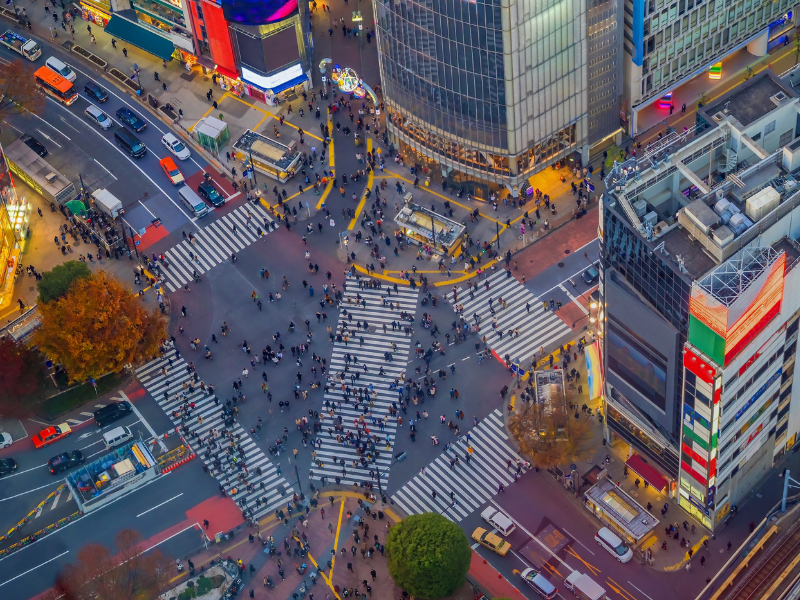
Often called “The Scramble,” Shibuya Crossing is one of the prominent attractions in Tokyo. It is a world-famous intersection situated outside Shibuya Station known as one of the busiest pedestrian crossings globally. Every time traffic lights turn red, hundreds of individuals rush into the junction from every direction and form an amazing display of organized disorder, which epitomizes the fast-paced city life in Tokyo. Apart from being a busy crossing, Shibuya Crossing represents modernity in Tokyo and acts as a famous cultural and entertainment district.
Cultural & Urban Relevance
Global Icon: As it has appeared in many movies, music videos, adverts among others, Shibuya Crossing has become synonymous with Tokyo and urban Japan at large. The giant digital screens and neon signs on its billboards are indicative of the city’s highly energetic atmosphere as well as technology achievements.
Social Hub: Often considered the heart for Japanese youth culture where most fashion and entertainment trends originate from, around Shibuya Crossing.
Nearby Attractions
- Hachiko Statue: A popular meeting point erected only steps away from the crossing to honor Hachiko – Japan’s most renowned faithful dog.
- Shibuya 109: This trendy shopping mall has been at the forefront of young women’s fashion in Japan since it opened its doors; it represents a landmark itself.
- Yoyogi Park & Meiji Shrine: Only a brief stroll away from Shibuya Station, these places provide respite from bustling streets ideal for an easy afternoon walk.
Tokyo Skytree
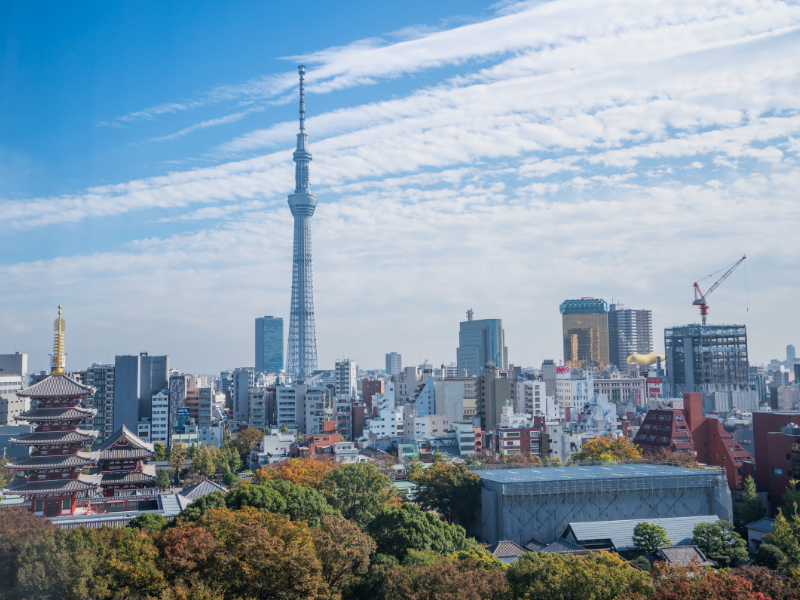
Tokyo Skytree, as an architectural wonder and a marvel of modernity, is one of the world’s tallest structures and Japan’s highest. With its debut in 2012, it has proved to be a tower for television transmission and also a top tourist destination with awe-inspiring panoramic scenes of Tokyo beyond. Its futuristic design coupled with sophisticated technology make it stand out as an emblem of Tokyo’s constant progress and dynamism. Situated in Sumida District, Tokyo Skytree has become an iconic feature in the city’s cultural and recreational environment encompassing museums, shopping centers, traditional neighborhoods.
Architectural and Technological Significance
Design & Structure: It was constructed to resemble a giant tree stretching into the sky symbolizing that exist from the bustling city below to the sky above. “Skytree White” is its unique color derived from Japanese tradition color “aijiro,” making it aesthetically harmonize with the surrounding urban area.
Seismic Proofing: The structure is equipped with advanced seismic proofing techniques including central pillar made up of reinforced concrete. It is one of the outstanding designs for earthquake-resistant architecture providing stability during frequent seismic activities in Tokyo.
Nearby Attractions
- Sumida Aquarium: Located at Skytree base, this contemporary aquarium contains several thousand marine species offering educational programs that are interactive enough even for children.
- Solamachi: This mall connected directly to Tokyo Skytree houses hundreds of stores and different eateries ranging from high fashion brands to typical Japanese crafts or souvenirs.
- Asakusa: A short distance away lies this historical district renowned for Senso-ji Temple, old-fashioned shopping streets, as well as its antiquated charm which contrasts vividly with modernity seen in Tokyo Skytree.
Imperial Palace Garden

Nestled in the heart of Tokyo, the Imperial Palace East Gardens serve as a tranquil escape from the urban sprawl that is Tokyo. They are located within the inner palace and are open for public access; thus, giving those who visit them a chance to catch a glimpse of the gardens surrounding the Japanese emperors home that is taken through carefully preserved landscapes. The Imperial Palace East Gardens were once part of Edo Castle which was considered as one of Japan’s most prominent edifices during Edo period before it became an imperial residence making it more than just beautiful scenery but a place of historical relevance.
The History Behind It
Background to Edo Castle: The gardens themselves were built over what used to be Edo Castle, where Tokugawa shogun lived in ancient times. A moat, some walls and guardhouses still exist as evidences of how much history Tokyo carries with her.
Metamorphosis: After Meiji Restoration, this castle was converted into Imperial palace while its gardens were eventually made accessible to members of public who wanted to learn about its long standing relationship with imperial family.
Characteristics of the Garden
Varying Flora: The garden presents different trees, flowers and plants all year round since they change depending on seasons. When spring comes cherry blossoms bloom while during summer irises do followed by autumn when vivid colors become visible making these lovely gardens favorites amongst both locals and tourists.
Arrangement of Landscape: Manicured lawns are found in these gardens along with quiet pools and pruned box hedges among others strategically placed to create harmony and tranquility.
Nearby Attractions
- Imperial Palace: Although not always opened up for public viewing inside the palace precincts but guided tours are organized within certain days annually.
- Tokyo Station: Located nearby is Tokyo Station which is popularly known due to its transport links but is also worth visiting because it has several shops restaurants and remarkable architectural structures.
- Marunouchi: An upmarket shopping and dining area known for class, which is a good place to end the day after visiting different sites.
Ueno Park
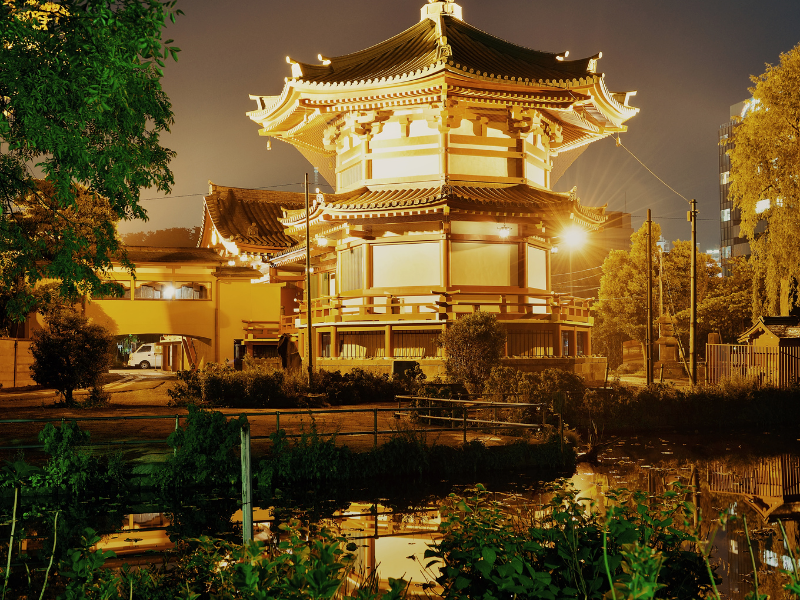
Ueno Park, found in the lively Taito district of Tokyo, is an extensive public space known for its past, cultural organizations and seasonal beauty. It was one of Japan’s first public parks when it was founded in 1873 on the site of a former temple. Ueno Park remains popular with both locals and tourists alike, as it boasts several museums, a zoo and picturesque scenery. This green oasis in the heart of metropolitan Tokyo offers a wonderful mix of nature, culture and leisure.
Historical and Cultural Significance
Origins: The park used to be part Kaneiji Temple – one of the largest and wealthiest temples in the city before it was turned into a public park after Boshin War aimed at modernizing Japan through westernization.
Cultural Centre: There are many cultural establishments that include Tokyo National Museum; National Museum Of Western Art designed by LeCorbusier; Ueno Royal Museum among others not forgetting Ueno Zoo which happens to be Japan’s oldest zoo being built here too.
Places to Visit
Museums: Within its premises stands the Tokyo National Museum which houses world’s largest collection of Japanese art works while another museum found here is called The National Museum Of Western Art where various western paintings can be admired especially those done by famous artists like Van Gogh among others; this structure has been declared UNESCO World heritage site due its architectural design was created by LeCorbusier himself.
Ueno Zoological Garden: Known as home ground for over 3000 different species animals including giant pandas; therefore making it a much-loved destination among families with children who have deep affection towards animals.
Parks & Recreation Areas: In spring time there are more than thousand cherry trees which blossom thus creating beautiful pink-white flower carpet throughout entire park area attracting lot visitors to come view them every year hence why Ueno park becomes so crowded during this season also Shinobazu pond becomes attractive spot for visitors in summer due lotus flowers blooming on its surface plus one can rent boats here.
Nearby Attractions
- Ameyoko Market: Just few steps from exit gate number four there is famous shopping lane called Ameya-Yokocho where you can buy anything ranging from fresh foods up to clothes and souvenirs etc thus making it perfect place do some shopping after visiting Ueno park.
- Asakusa & Senso-ji Temple: Another interesting place worth seeing located not far away from Ueno park is Asakusa district which houses oldest Buddhist temple in Tokyo called Sensoji- temple.
Akihabara
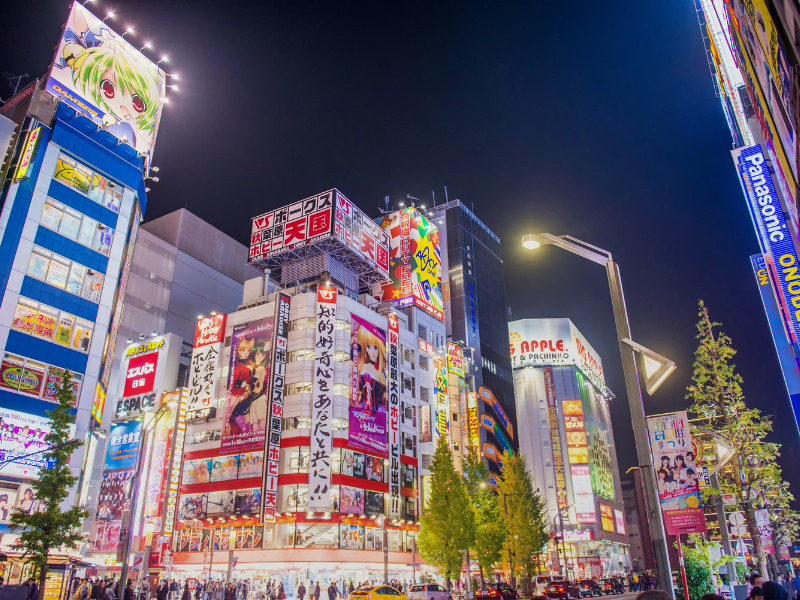
Akihabara, fondly referred to as “Akiba” by locals, is a bustling representation of Japanese pop culture and state-of-the-art technology. Once known for its numerous electronics stores, it has transformed into a global mecca for anime, manga and video game fans alike. Situated in Tokyo’s Chiyoda ward, the vibrant district provides various shopping options, themed cafes and entertainment that cater to every facet of otaku culture.
Cultural and Urban Significance
Electronics Hub: Following World War II when it served as an illicit radio parts market, Akihabara became famous in the late 20th century as Japan’s premier destination for household consumer electronics. The focus has changed somewhat since then but still you can find many stores selling everything from cutting-edge gadgets to rare vintage items.
Otaku Paradise: Today Akihabara boasts countless shops specializing in anime/manga and video games — places like Mandarake are treasure troves full of collectibles ranging from figures/statues/figmas to out-of-print/rare manga volumes etcetera.
Unique Attractions and Experiences
Maid Cafes: Known as the birthplace of the Maid Café concept — where waitresses dressed as maids serve customers while treating them like masters — Akihabara has several such establishments you can visit.
Themed Cafes & Restaurants: In addition to maid cafes there are other types too; some may be centered around popular anime or video game titles thereby providing fans with fully immersive dining experiences etcetera.
Anime & Manga Shops: Large stores like Animate and Super Potato have multiple floors dedicated entirely to DVDs/BDs (Blu-Ray Discs), comics/manga books/graphic novels/manhwa/manhua/mahua/etc., toys/action figures/figurines/statuettes/gashapon machines/card games/trading cards/keychains/buttons/t-shirts/posters/wall scrolls/cosplay costumes etcetera — catering mostly for hardcore fans.
Nearby Attractions
- Kanda Myojin Shrine: Just a short walk away from bustling Akihabara, this shrine provides a quiet contrast and is known to bless electronic devices/gadgets.
- Ueno Park & Ameyoko Market: A few minutes by train will take you to these places which offer cultural as well as shopping experiences ranging from serene park walks to bustling market bargains.
Ginza District
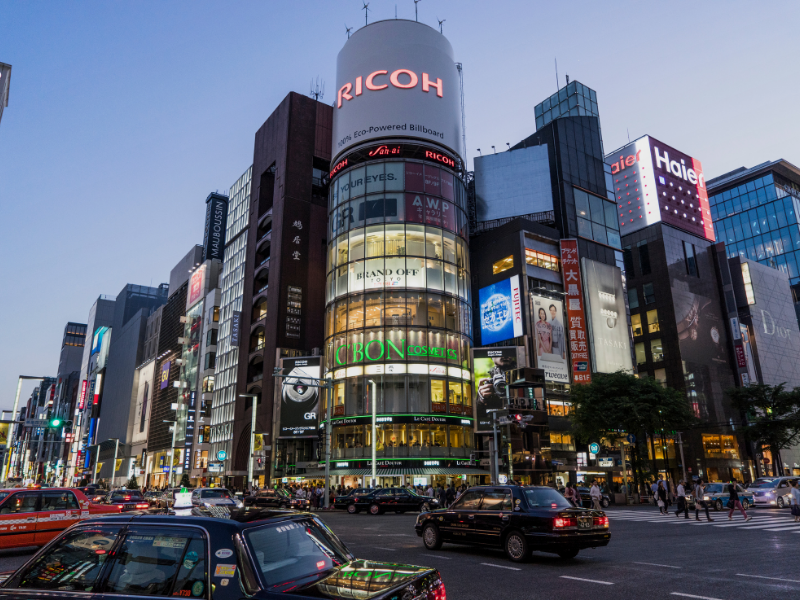
Tokyo’s best-known commercial district is Ginza, which boasts of being the most famous place for shopping, eating and arts. It’s a sophisticated and luxurious location that blends old establishments with modern architecture. Originally a swamp, this area was turned into a silver coin mint in the 17th century, hence its name ‘Ginza’ meaning “silver mint” in Japanese. Today it is an international shopping paradise filled with luxury brands from all around the world as well as top gastronomy spots and cutting-edge art exhibitions – a must visit for any tourist in Tokyo.
Architectural Marvels
Modern Wonders: Sleek Ginza Place towers over other buildings on Ginza’s skyline along with iconic neo-classic facade building ‘Wako’ which has become known to many people because of its clock tower while there are also glass walls surrounding luxury mall complex called ginza six.
Historical Gems: Even though surrounded by modernity, one can still find places like Kabuki-za Theatre where traditional Japanese kabuki performances are held thereby preserving cultural heritage against rapid modernization.
Shopping & Entertainment
Luxury Brands: The word ‘Ginza’ is synonymous with high-end fashion. Exclusive products can be found at flagship stores of famous brands such as Chanel or Cartier while Apple offers premium shopping experience through their unique gadgets available only here. For those who appreciate good design and expensive clothes – this definitely should not be missed out on.
Art Galleries & Culture: There are many different types of galleries located within this district ranging from contemporary ones showcasing newly emerging artists to classic ones exhibiting works done by established masters like Van Gogh himself; examples include Shiseido Gallery or Ginza Graphic Gallery among others – so you can easily find something interesting for yourself.
Places To Eat
Gastronomic Delights: If you’re looking for some really delicious food then head straight towards one of those Michelin starred restaurants situated in Ginza like Kyubey which is known as the best sushi restaurant in the world. However, if your palate craves more diverse tastes then don’t worry because there are places where they serve French haute cuisine or even fusion dishes created by mixing together ingredients from different countries.
Café Culture: If you get tired after shopping all day long and need to rest somewhere nice while having cup of coffee or tea – no problem! There are plenty cute little cafes scattered around where you can enjoy your favorite drink accompanied with traditional Japanese sweets such as dorayaki pancakes filled with red bean paste for example.
Nearby Attractions
- Tsukiji Outer Market: This famous fish market is just few minutes away from Ginza so it’s definitely worth visiting if only for seeing all those big fish on display and smelling fresh seafood everywhere around you.
- Imperial Palace: Located not too far away from here lies an imperial palace surrounded by beautiful gardens where visitors can take long peaceful walks along its centuries old walls while admiring stunning views over Tokyo cityscape . It offers great opportunity escape hustle bustle downtown area.
Tsukiji Outer Market
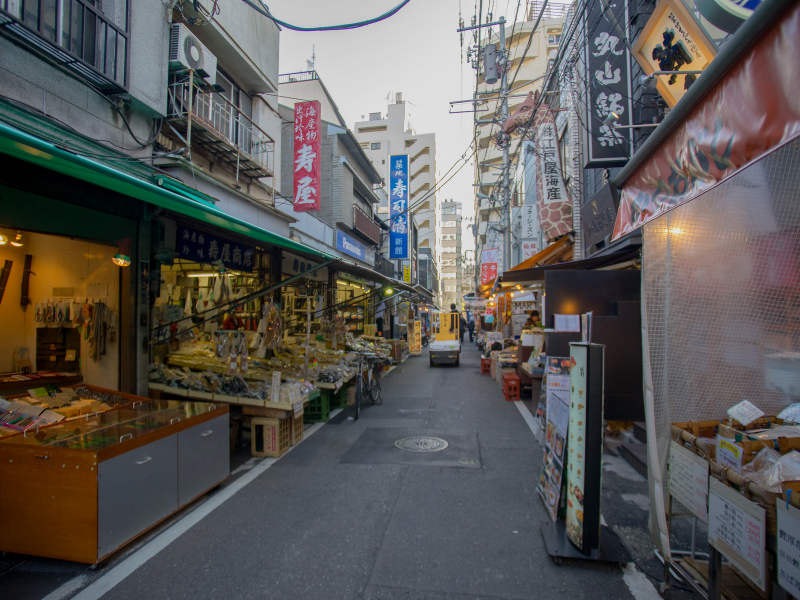
Sociated among the busy streets of Tokyo, Tsukiji Outer Market is a lively reflection of Japan’s culinary heritage. Even though the inner wholesale market has been relocated to Toyosu and known for its tuna auctions, the outer market still flourishes as it provides various fresh seafood, vegetables, and other Japanese food-related products. In Japanese called “Tsukiji Jogai Shijo,” this market remains among the favorite destinations for both locals and tourists who want to discover more about the dynamic food scene in Tokyo.
Cultural Significance
Historical Foundation: Since 1935 Tsukiji Market has been an essential part of Tokyo’s food culture acting as a central distribution point for seafood throughout Japan. This legacy lives on in the outer market where one can get a glimpse into what makes this city’s gastronomy tick.
Foodie Heaven: The market itself is filled with restaurants that sell fresh sashimi, sushi and many other types of Japanese cuisine which are considered true delicacies even by locals themselves not just visitors from abroad. From street stalls to traditional dining establishments there seems to be no end when it comes down variety here.
Market Attractions
Fresh Seafood: This place offers some if not THE freshest seafood any visitor will ever taste in their life; you name it – they have got it! There are stalls selling huge tunas or live scallops among other things but what really sets apart Tsukiji (and makes visiting worth waking up early) is those delicious breakfasts where plates after plates full with pieces made out raw fish chosen right off from these very waters come rolling towards your table non-stop until you say ‘stop’…or run out space on your plate – whichever comes first.
Specialty Shops & Local Products: If anything else than just being about fish were needed then let me tell ya bout all them stores dealing mainly with kitchenware required during preparation certain meals originating within this country. There’s also those handmade blades plus various other specialty items used exclusively by professional chefs engaged in Japanese culinary arts…or people who simply love cooking stuff from there like me.
Street Food & Local Eateries: The streets surrounding Tsukiji Outer Market are lined up with small stalls selling all sorts of treats that can be eaten on the go – tamagoyaki (Japanese omelette), grilled seafood skewers and traditional sweets among others. Every single one represents a chance for any visitor to try out some authentic flavors making up Tokyo’s diverse food palette so don’t be shy, just give them all shot while you’re at it.
Nearby Attractions
- Hamarikyu Gardens: These traditional Japanese gardens make for an ideal peaceful break away from the bustling market. Beautiful ponds teeming with koi fish, serene tea houses and seasonal flower displays await visitors here.
- Ginza: Luxury shopping district Ginza is just a short 15-minute walk away from the market. High-end department stores, art galleries and Michelin-starred restaurants can be found in abundance here.
- Sumida River: Running close by to Tsukiji Outer Market, the Sumida River offers scenic walking paths and river cruises. Take in views of Tokyo from a different perspective as you stroll along this historic waterway.
Odaiba

Odaiba is a present-day and popular entertainment district that was built on a man-made island in Tokyo Bay. Distinguished by its avant-garde architecture, gigantic shopping malls and numerous recreational facilities, this place has many different things to do for people of all ages and interests which is why it is highly liked by both locals as well as tourists.
Originally constructed as some small fort islands meant for defense during the 1990s construction boom, Odaiba has evolved into an area teeming with attractions ranging from amusement parks where one can relax after work or school hours such as leisure facilities to shopping complexes offering various goods including clothes among others alongside with restaurants providing delicious meals not forgetting breathtaking views over Rainbow Bridge together with Tokyo’s skyline thus making itself impossible not to visit when coming around Japanese capital city.
Architectural Wonders & Sights
Futuristic Design: Amongst Tokyo’s most modern buildings are situated in Odaiba – Fuji TV Building boasts a peculiar spherical observatory deck while Telecom Center features an observatory that offers panoramic outlooks across Tokyo Bay plus surrounding towns.
Different Attractions: Fun things abound within this region; Palette Town alone houses several entertainment venues comprising of Venus Fort designed like 18th century European town complete with artificial sky ceiling painted pink at sunset besides DiverCity Tokyo Plaza where at night fall lighting up gigantic Gundam statue (20 meters high) becomes breath taking view indeed.
Culture And Recreation Highlights
Museums And Galleries: Miraikan (The National Museum of Emerging Science and Innovation), on the other hand displays interactive exhibits on future technology among other environmental issues teamLab Borderless digital art museum known for its stunning visual displays as well innovative installations should not be missed too.
Resting Spots & Leisure Facilities: When it comes down to unwinding there is nowhere better than here; Oedo-Onsen-Monogatari provides hot springs that recreate Edo period atmosphere complete with natural hot springs plus traditional Japanese entertainment.
Beach & Water Sports: For those who love water activities, this artificial beach offers sunbathing spots as well picnic grounds while allowing visitors to enjoy various water sports within city’s reach.
Shinjuku Gyoen National Garden
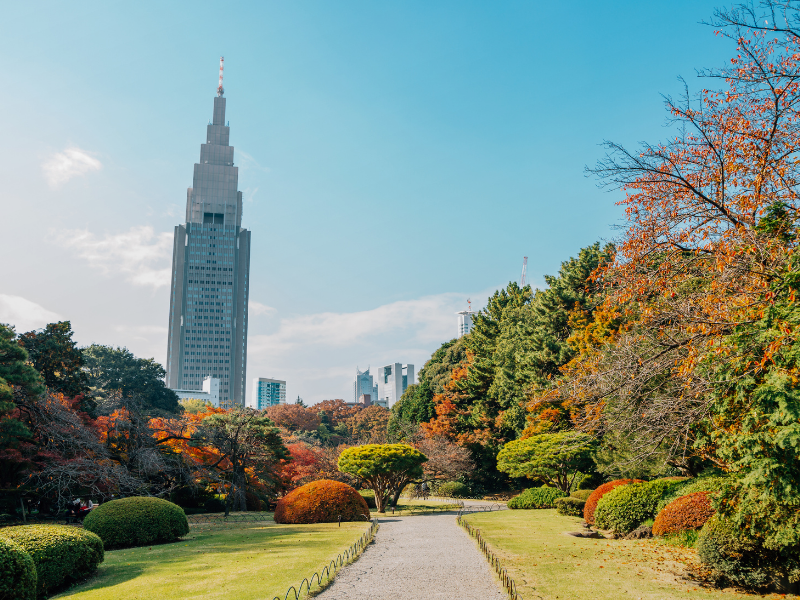
Found in the midst of one of Tokyo’s most vibrant neighborhoods, Shinjuku Gyoen National Garden is a peaceful respite from the city’s constant motion. First built as an imperial garden in the late 19th century and later opened to the public in 1949, this expansive park seamlessly combines three different kinds of gardens – classic Japanese, French formal, and English landscape. Covering 58.3 hectares and populated by over 20k trees, it is famous among both locals and visitors for its picturesque walking trails, serene scenery and seasonal beauty.
Design and Features
Three Garden Styles: The heart of Shinjuku Gyoen lies in its Japanese traditional garden which includes many carefully maintained ponds, bridges and teahouses that give an insight into classical Japanese landscape design. The French garden boasts symmetrical patterns with neatly trimmed hedges creating an elegant atmosphere while the expansive English landscape garden is perfect for picnics or leisurely strolls.
Floral Displays: One of the highlights at Shinjuku Gyoen are its seasonal flowers. During springtime, visitors can witness breathtaking displays of cherry blossoms; early summer brings vibrant roses while autumn delights with warm hues all around. In addition to this there is also a greenhouse where various tropical plants from different parts of Asia can be found throughout the year.
Significance to Culture & Conservation
Historical Legacy: Originally serving as feudal lord’s residence before being turned into an imperial garden by Naito family during Edo period (1603-1868), this site became post-war national park managed under Ministry Of Environment Japan thereby signifying its importance not only as part Japanese cultural heritage but also natural preservation effort after World War II.
Eco-Conscious Management: It sets example sustainable urban green space management practices aimed at conserving biodiversity through environmentally friendly approaches within park boundaries.
Nearby Attractions
- Shinjuku Skyscraper District: Just few minutes’ walk away from Shinjuku Gyoen there is a skyscraper district where visitors can enjoy stunning views over Tokyo. The Tokyo Metropolitan Government Building located in this area offers free observation decks at its top floors.
- Kabukicho: Known as entertainment and red-light district of Tokyo, Kabukicho provides an exciting contrast to the calmness found within Shinjuku Gyoen with its vibrant nightlife scene full of bars, clubs and various other entertainment establishments.
- Isetan Shinjuku Store: A luxury department store near Shinjuku Station which offers wide range of high-end goods as well as gourmet food options making it ideal for both shopping and dining.
Roppongi Hills

Roppongi Hills, a towering and multifaceted development in the heart of Tokyo’s Roppongi district, epitomizes the blend of modernity and culture that characterizes contemporary Tokyo. From its launch in 2003, this area has been viewed as an urban innovation landmark where office space, apartments, shops, restaurants as well as cultural establishments are combined into one complex. This “city within a city” was designed not only for business efficiency but also for cultural enrichment and leisure activities thus making it unique among other places visited by locals or tourists.
Architectural and Urban Design
Mori Tower: Spanning 54 stories high above ground level Mori Tower is not just about office spaces; it hosts both Mori Art Museum along with an observatory deck providing breathtaking views over Tokyo City including Tokyo Tower which can be clearly seen from here on sunny days when visibility is good and sometimes even Mount Fuji too.
Sculpture Garden & Public Spaces: The development features attractively designed open-air areas like Mori Garden which combines traditional Japanese garden elements with contemporary urban design concepts while being dotted around with public arts installations among others thereby enhancing its ambience.
Cultural Highlights
Mori Art Museum: Situated at the fifty third floor of Mori Tower this museum exhibits mainly modern-day works created by domestic artists as well as those from abroad. Sometimes they have exhibitions on architecture or design besides visual arts alone.
Cinema Complex: Among other things there is TOHO Cinemas Roppongi Hills – one of the largest cinema complexes housing many screens where various films are shown throughout the year such as premieres or even during Tokyo International Film Festival among others.
Shopping and Dining
Diverse Culinary Offerings: There are numerous eating places within Roppongi Hills ranging from casual cafes to fine dining restaurants so whatever type of food you may be craving for whether Japanese cuisine Italian French etcetera you will find it here.
Shopping & Fashion: Many fashion boutiques and high-end stores offering crafts luxury goods etcetera are located within the complex thus making it a great place to shop if crowded places like Shibuya or Shinjuku do not appeal much to you.
Nearby Attractions
- Roppongi Art Triangle: Roppongi Hills is part of the “Art Triangle Roppongi” that also includes The National Art Center as well as Suntory Museum of Art which are all situated close enough for art enthusiasts who want more than just one venue.
- Midtown Tokyo: Midtown Tokyo which hosts additional cultural facilities such as Suntory Museum of Art among others where visitors can explore further after visiting Roppongi Hills itself being only a short walk away from here.
Harajuku and Takeshita Street

Harajuku, particularly Takeshita Street, is a symbolic place in Tokyo where one particularizes vibrant youthful culture, style revolution and lively streets. Situated adjacent to the peaceful Meiji Shrine, Harajuku stands out with its energetic environment and shops painted in different colors. This area is widely known as the center of Japanese youth culture and fashion worldwide which attracts tourists who want to try out new combinations of current trends mixed with street styles.
Cultural Importance
Fashion World: For a long time now Harajuku has been considered as the birthplace for most Japanese youth fashion trends. It is common to see various looks like cute Lolita or rebellious Ganguro on this part of town especially during weekends when many young fashionistas gather around to show off their latest creations.
Subculture Mix: Being always up-to-date according to what’s fashionable among Japan’s stylish young people makes it an ideal place for them to hangout because everything changes too fast there from cafes which sell clothes reflecting newest subcultures through street performances showcasing them.
Experience at Takeshita Street
Paradise for Shoppers: Lines of boutiques,vintage clothing stores and fashion outlets selling everything between gothic wear up to handcrafted accessories can be found along the 400m narrow street called Takeshita. In other words we can say that while being there you have access not only for high street fashion but also niche subcultural products.
Food Heaven: Moreover apart from all those wonders it offers some really unique snacks & sweets like rainbow cotton candy, crepes filled with different stuffings etc which are not only tasty but also very photogenic so perfect for Instagramming!
Dynamic Environment: The atmosphere at Takeshita Street vibrates – music comes out loud shops display their goods using bright colors then mix it up well with crowds constantly flowing by dressed in fashionable outfits. All this creates such liveliness that you cannot just pass through there without stopping for a while to look around people-watch or simply soak in youthful spirit of Japan’s capital.
Nearby Attractions
- Meiji Shrine: After some minutes’ walk from busy Takeshita Street one can find oneself within calmness of Meiji Shrine’s vast precincts.
- Yoyogi Park: Located next door to Harajuku area Yoyogi Park becomes an excellent choice if you need rest after long day spent on shopping and sightseeing here.
- Omotesando: Sometimes referred as Tokyo’s Champs-Élysées this wide street lined with elm trees offers more stylish cafes along designer boutiques where you have opportunity for upscale shopping experience unlike any other place in Japan.
Nakamise Shopping Street
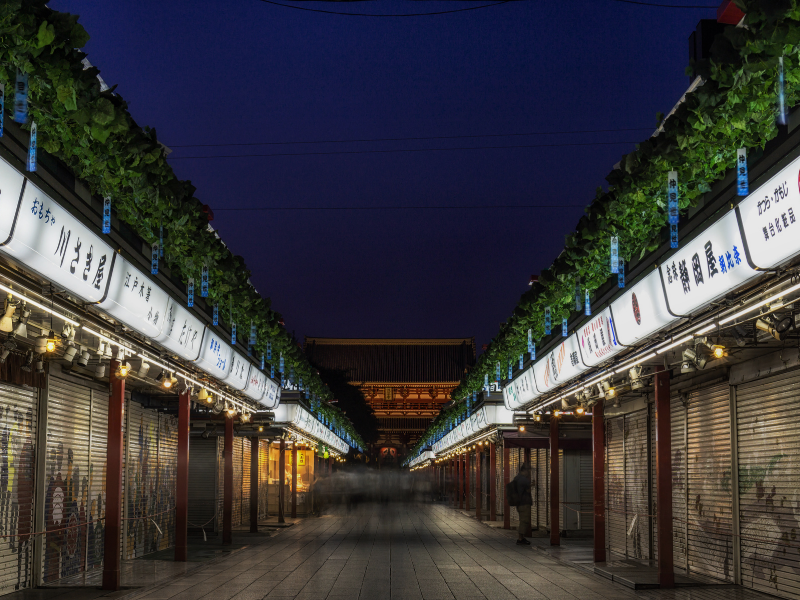
Nakamise Shopping Street is located in the historical area of Asakusa and is one of the oldest and most famous shopping zones in Tokyo. The street stretches for about 250 meters from Kaminarimon (Thunder Gate) to Senso-ji Temple, which is considered sacred by many. Here you can take a leisurely walk among traditional shops and food stalls that represent various aspects of Japanese culture. It is not just a shopping street, but also an opportunity to immerse oneself into the life of ancient and modern Tokyo.
Cultural & Historical Importance
Historical Market: Nakamise has been serving temple visitors since Edo period thus forming part and parcel with Asakusa history itself; therefore it remains important up to now among them being its authenticity where majority shops along this road sell genuine crafts made locally within Japan while offering snacks too.
Architectural Features: Rows upon rows packed closely together line both sides of what would seem like small alleys were it not for their numerous vendors selling all manner souvenirs giving off such an ambiance representing old times gone by made possible through use wood as material used constructing these structures.
Shopping & Culinary Wonders
Traditional Goods: This is where you should go if you are looking for traditional Japanese souvenirs like yukata robes, folding fans or even paper lanterns. All these items are crafted skillfully in accordance with aesthetic sense that belongs purely to Japan alone.
Local Snacks & Sweets: There’s no better place than Nakamise Street when it comes to trying out different types of cheap but tasty local snacks such as ningyo-yaki which are small cakes filled with sweetened red bean paste then baked on spot before sold alongside kaminari-okoshi another type crispy rice cracker usually enjoyed during festivals throughout year followed closely behind by variety mochi rice cake treats stuffed fillings ranging from fruit flavors right down savories like soy sauce or azuki bean paste. Such snacks don’t just taste great but they also give people an idea about what kind of foods have been popular in Tokyo over ages.
Nearby Attractions
- Senso-ji Temple: Known as the oldest Buddhist temple in Tokyo and located at the end of Nakamise Street, this place boasts an impressive history besides its magnificent architecture; therefore it is worth every tourist’s attention who visits Asakusa area for first time.
- Asakusa Shrine: A Shinto shrine next to Senso-ji which provides serene atmosphere ideal places for meditation especially during peak hours when there’s lot activity going on within vicinity such prayers being made by religious devotees thus creating perfect balance between two major religions found here Buddhism & Shintoism.
- Sumida River: Not far from where we are right now stands one those beautiful Japanese rivers called Sumida river; so whether taking scenic boat tour down along its banks or simply having walk around area will give chances see different side city that may haven’t seen before.
Asakusa Culture and Tourist Center

The Asakusa Culture and Tourist Information Center is located in a lively district known for its history and traditional culture. A great number of people who visit Tokyo regard it as the important place to gain information about this interesting area. Kengo Kuma, the world-famous architect designed this modern building, which is considered one of his splendid works. Therefore, it provides services that can help tourists have a good trip experience. Moreover, those services range from detailed descriptions of local attractions to beautiful panoramic views over the surrounding area such as Senso-ji Temple and Tokyo Skytree.
Architectural Excellence
Innovative Design: Unique structure with stacked terraces like pagodas gives it an outstanding appearance among other buildings in Asakusa which imitates old wooden houses used long time ago in Japan for housing purposes.
Viewing Decks: Many observatory decks are offered by the center where you can see Nakamise Shopping Street directly and beyond that whole Asakusa area will be seen at once. These heights are really useful for photographers or those who want to have an overview about this bustling district from above.
Visitor Services
Information Services: The establishment provides their guests with guides in multiple languages on places worth visiting, dining out options or shopping opportunities both within Asakusa itself and wider Tokyo metropolitan region; complimentary maps & brochures too so that sightseers can find their way around easily and plan what they would like to do during their stay.
Cultural Exhibitions: From time to time exhibitions displaying local crafts, arts and cultural heritage take place here thus allowing visitors learn more about various aspects of life being lived out in different parts within Asakusa community alone but also throughout whole city area as well .
Amenities: Free Wi-Fi hotspots have been installed throughout the building’s premises together with charging stations scattered all around rest areas meant for tired travelers seeking refuge before continuing on with other activities planned for the day.
Nearby Attractions
- Senso-ji Temple: This old Buddhist temple lies only few minutes’ away from our location; it is one of the most ancient and largest temples in Japan, which can be recognized by its huge gate adorned with a massive lantern.
- Nakamise Shopping Street: Stretching between Kaminarimon Gate leading directly into Sensoji area itself, this vibrant street offers visitors an opportunity to buy traditional snacks or souvenirs while admiring various works done by local artisans using different materials .
- Sumida River: Running close alongside Asakusa district boundaries, this river provides perfect conditions for taking pleasure boat rides that allow tourists marvel at another side of Tokyo’s skyline.
Tokyo National Museum

The Tokyo National Museum, which is located in Ueno Park, is the oldest and largest museum in Japan. It was established in 1872 as a place to store all art works collected from various parts of Japan including other Asian countries. This offers not only an opportunity for people to learn about history and culture but also serves as a gateway into wider asian heritage therefore making it compulsory amongs historians, artists or anyone with interest on this richly varied region.
Architectural and Cultural Significance
Historic Buildings: Several buildings make up these facilities; each one well known for its architectural beauty. The Japanese Gallery (Honkan) built in 1938 features ancient pottery such as samurai armour and delicate scrolls among other japanese works of art.
Extensive Collections: The range here is wide with over 110,000 items including 87 national treasures of Japan plus further 610 important cultural properties being representative examples taken from all corners across Asia thereby giving us an unmatched chance to explore more about Asians through their arts and crafts.
Exhibits and Galleries
Diverse Art Forms: Different kinds of arts can be found throughout different parts within the museums’ compound. Traditional Japanese art forms are displayed at Honkan while that from other parts of Asia is housed at Toyokan. Special exhibitions take place at Hyokeikan or Heiseikan alongside Treasures from Horyu-ji Temple displayed inside Horyuji Homotsukan.
Interactive And Educational Displays: Besides looking at pieces exhibited there, knowledge behind them should also be sought after so they have made sure international visitors don’t miss anything by providing interactive displays which bring historical artifacts alive through multimedia guides together with English descriptions.
Nearby Attractions
- Ueno Park: There are several museums located around this park hence making it ideal for spending whole day enjoying culture-rich environment .
- Ueno Zoo: This zoo is just within walking distance; being the first zoo ever built in Japan it has remained one of the most popular places where families visit frequently.
- Ameyoko Market: After visiting a museum, you might want to do some shopping and this bustling market is just few minutes away from Ueno Park.
Kabukicho

Kabukicho, also known as the city that never sleeps is located at the heart of shinjuku in Japan’s capital city. This area is famous for its thrilling nightlife, bright neon lights and various amusement parks which give a glimpse into different parts of adventurous Tokyo. Whether you are a fan of lively bars and clubs, curious about love hotels or interested in visiting themed restaurants; kabukicho is the place to be if you want to discover what happens when the sun goes down in this vibrant metropolis.
Culture And Ambiance
Buzzing Nightlife: The moment night falls on Kabukicho, streets become packed with people coming from every corner of Japan. Huge numbers of neon signs light up the district all night long creating an atmosphere full of energy that attracts revelers from all over.
Cultural Oasis: Though it may look like nothing more than an adult entertainment area, this neighborhood acts as a cultural melting pot where many traditional Japanese forms of entertainment such as hostess clubs, pachinko parlors or live music venues thrive side by side.
Points Of Interest
Robot Restaurant: Robots Restaurant is one place that can only be found in kabukichō – here it’s just bulbs! This venue represents everything weird about modern tokyo shows being robots fighting against each other under flashing lights accompanied by loud sounds.
Golden Gai: Located just a short walk away from central Kabukichō along narrow backstreets lined with tiny bars; each having its own unique theme or decoration making them perfect for anyone looking for somewhere quieter to drink late into the night before heading home after sunrise.
Godzilla Head: At Hotel Gracery Shinjuku stands huge Godzilla head which has become one iconic image associated with theatrics often found within Kabukicho itself – this monster roars loudly while people take pictures next to him pretending they are terrified out their wits.
Nearby Attractions
- Shinjuku Gyoen National Garden: If you want to catch your breath before diving into the lively streets of kabukicho take a stroll around this vast park where you can enjoy some peace and quiet surrounded by nature.
- Omoide Yokocho: Known locally as Memory Lane or Piss Alley; it is an alley close to Kabukicho that offers various small eateries serving yakitori among other traditional Japanese street foods – the ideal counterpoint to the night-time entertainment just around the corner.
Hamarikyu Gardens

Tokyo’s Hamarikyu Gardens is located within the city’s high-rise buildings. It is a quiet and beautiful place for people to stay away from the hustle and bustle of the city. The park has a long history. It used to be the residence of feudal lords and hunting grounds for Tokugawa shoguns, but now it is open to the public. It is an excellent example of garden design during the Edo period in Japan. There is a seawater pond that ebbs and flows with tides. This garden was preserved well, so it still shows traditional Japanese gardening style while being surrounded by modern skyscrapers in Tokyo, which attracts both history lovers and nature enthusiasts.
Historical Significance and Design
Edo Period Features: These are two ponds where ducks were hunted; they have an island teahouse on them as well as carefully tended paths typical to feudal Japanese landscapes.
Tidal Pond: Located at its center, this main pond connects directly with Tokyo Bay letting sea water flow into it. Hamarikyu Garden boasts having one that changes levels naturally through sluices acting according to tides’ rhythm – a very rare thing among similar facilities throughout Japan.
Seasonal Beauty and Activities
Flower Displays: The park offers many flowers depending on seasons; during springtime delicate pink cherry blossoms cover trees making them look like canopies while autumn brings warm colors thanks to leaves turning yellow or red mainly because ginkgoes and maples are planted hereabouts.
Tea House Experience: Nakajima-no-Ochaya tea house serves matcha green tea alongside other types accompanied with traditional sweets giving guests opportunity not only taste authentic beverages but also enjoy peaceful atmosphere overlooking scenic views provided by ponds within vicinity.
Nearby Attractions
- Tsukiji Outer Market: Within walking distance lies one of Japan’s most famous food markets where fresh fish is sold among other things giving visitors chance experience authentic Japanese cuisine firsthand while enjoying vibrant atmosphere created by bustling crowds frequenting this place daily.
- Ginza Shopping District: Hamarikyu Gardens serves calm oasis amidst busy urban setting represented by fashionable shops lining streets filled with people hurrying from one location another searching for latest trends exclusive brands not forgetting about savory dishes served in chic restaurants scattered throughout area.
- Sumida River Cruise: Starting nearby pier; allows passengers view waterfront buildings historical district Asakusa futuristic island Odaiba passing under several bridges along way.
Tokyo Metropolitan Government Building Observation Decks
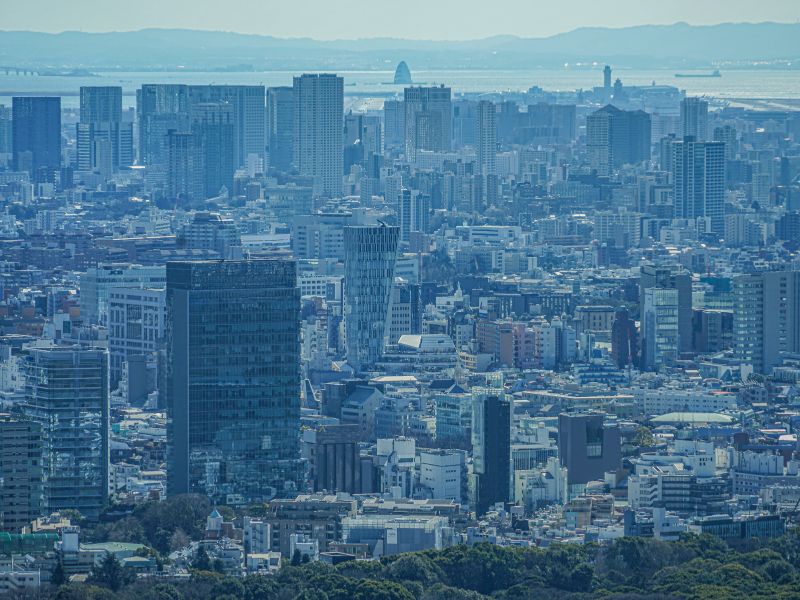
Situated in Shinjuku; the Tokyo Metropolitan Government Building (TMGB) is a great place to see Tokyo from above without paying anything. The TMGB has an original, unique and futuristic design created by Kenzo Tange who is a well-known architect. It comprises two towers each having an observatory deck that provides a panoramic view of Tokyo and its surroundings. Sometimes visitors can even see Mt Fuji if it is not cloudy. Because of its architectural beauty combined with scenic views, this building should not be missed by anyone including photographers, families or first-time tourists.
Importance
Design: It resembles either a Gothic Cathedral or computer chip which shows how technological advanced and innovative Tokyo. Being 243m tall, the twin towers are among the tallest buildings in shinjuku thus dominating its skyline.
Sustainability: There is also sustainability in mind when constructing this facility by using energy efficient materials and systems so as to reflect environmental consciousness within Tokyo city.
Observation Decks
North & South Towers: On their 45th floors about 202 meters above ground level, each tower contains an observation deck where visitors can enjoy wonderful views over Tokyo city especially during nighttime when lights are switched on thereby making everything glitter like gold dust.
Exhibition Spaces And Amenities: At these decks one will find cafes as well shops selling souvenirs besides informative displays that explain different landmarks visible from windows thus enhancing visitor’s experience while they watch.
Nearby Attractions
- Shinjuku Gyoen National Garden: This vast park situated near TMGB offers a nice contrast with urban setting of shinjuku hence providing a good place for leisurely walk after taking in heights around high-rise area such as those at TMGB
- Kabukicho: Known as entertainment district where many restaurants bars clubs etc can be found but also red light district featuring various adult entertainment establishments too like hostess bars or soapland massage parlors among others Isetan Shinjuku Store – Famous departmental store which offers high end shopping experience including wide range culinary delights particularly found within its food hall section.



